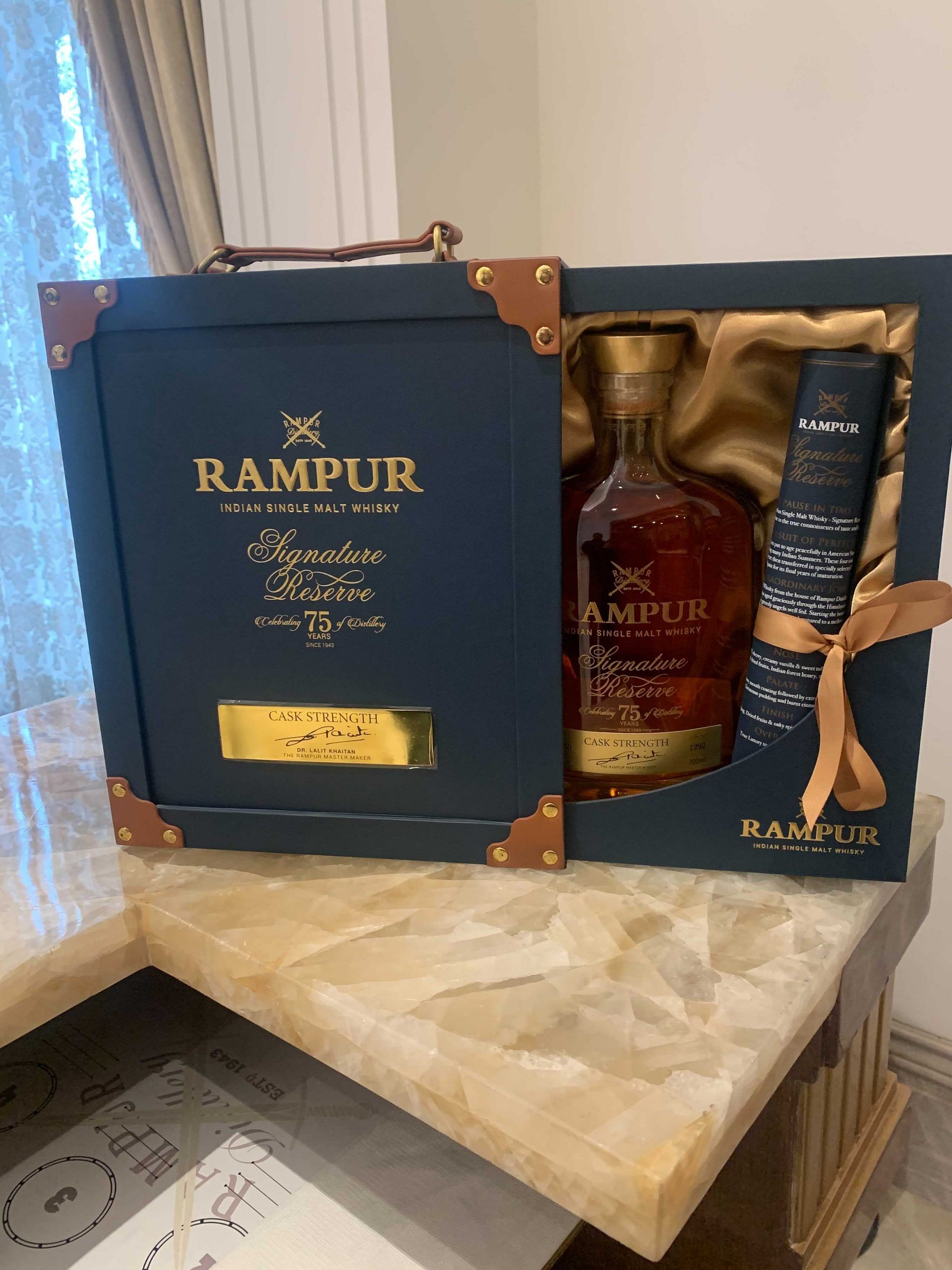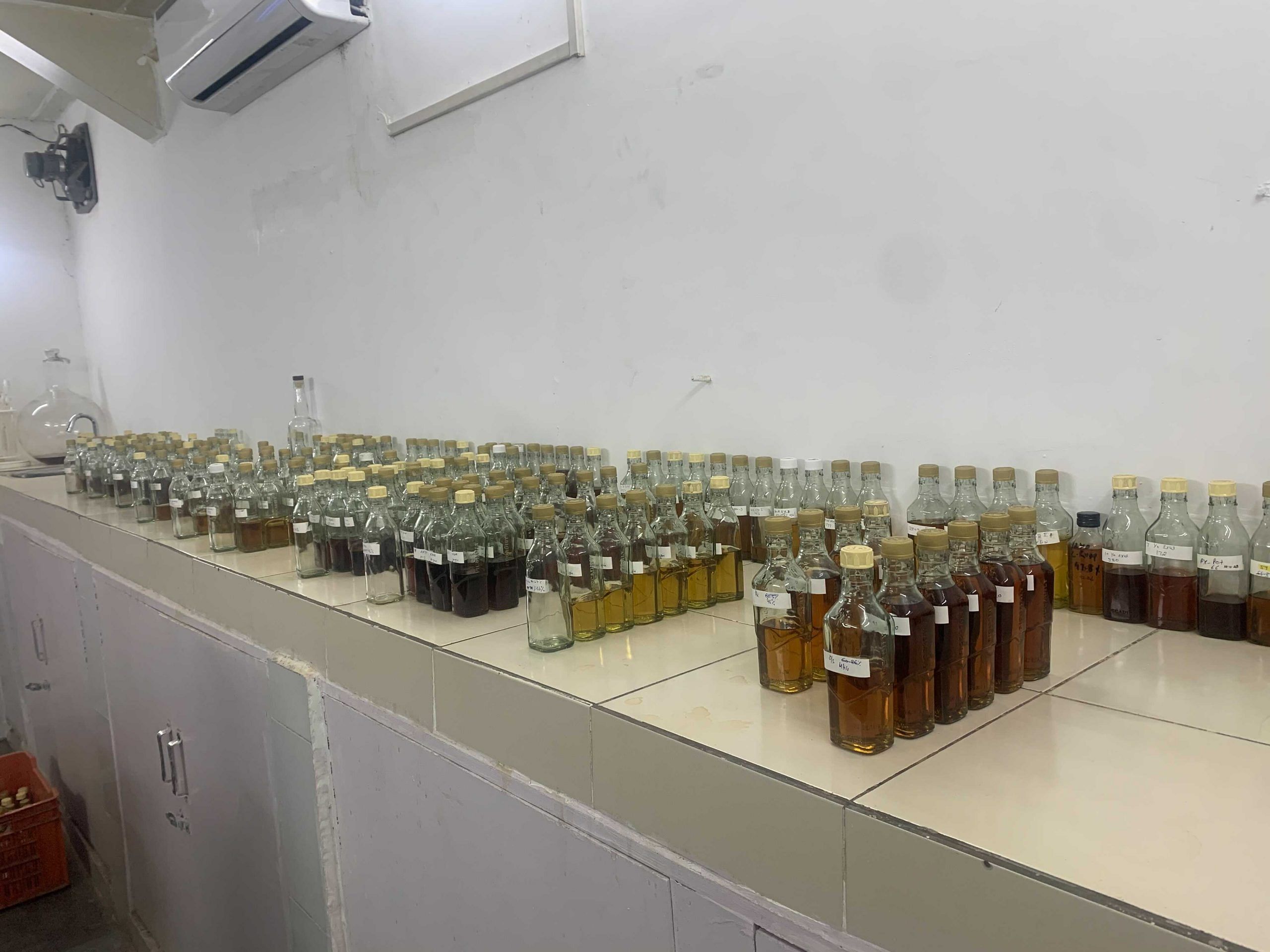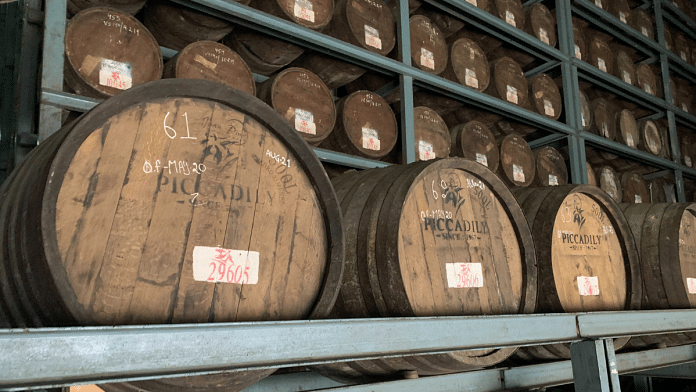Rampur: Of the 400 Rampur Signature Reserve single malt whisky bottles dispatched to countries around the world, only three remain, lingering on at the duty-free section of the Hyderabad International Airport. The bottles, each costing Rs 1.5 lakh, flew off the shelf in just three months. Aged in American bourbon and Spanish sherry casks, the whisky entered the market, was sold swiftly, and reaffirmed faith in the glory of the Indian single malt.
Radico Khaitan, the company behind this limited edition premium whisky, sings paeans to it on its website, calling it the “Kohinoor of Single Malts”. And it’s coveted not just in India but also internationally, and is sold in 18 European and Asian countries.
Indian single malt whisky is having its day under the global sun and topping the charts. The story is as much about a changing India as about how the world is looking at the country now. More importantly, the rise of Indian single malts like Paul John coincides with a burgeoning elite class and a wave of unprecedented national pride in all things Indian.
Named after the obscure towns and villages in which they are distilled, Radico Khaitan’s Rampur and Piccadily’s Indri alongside Paul John are part of a relatively new breed of single malts—internationally acclaimed and India-made. They exude flavours of tropical fruits and romantic, foreigner-friendly notions of the ‘Indian summer’.

India has always been a predominantly whisky-drinking nation. But now, the rise of homegrown single malts heralds a new era, pushing companies to elevate supply chains and permitting citizens to indulge in oaky, fruity, and flavourful notes of nationalist pride.
It’s not just the whisky — an entire new culture is being distilled with Amrut, Indri, Rampur, and Paul John.
“The recognition of our whisky has catapulted. Earlier, when we used to refer our communities to Amrut, only three out of 10 people would recognise it. They’d be more familiar with brands like Chivas or Glenfiddich,” says Hemanth Rao, founder of India’s first whisky appreciators club, SMAC (Single Malt Amateur Club). “Now, this number has gone up to seven or eight.”
Also read: Tulsi to strawberry—How desi gin from Goa is converting India’s vodka loyalists
‘Nose like a cat’
In the sleepy village of Indri in Haryana, where shop shutters are down even at 11 am, master distiller Surinder Kumar is surrounded by 200 bottles, each containing an extract from a different barrel. He picks one up and unscrews the lid. Pressing a nostril on the rim, he proceeds to take the smallest of sips — and is hit with an assortment of scents and a smooth finish.
For over three decades, Kumar has been “nosing and tasting” whiskies. He is the one behind Indri’s fruity introduction and oaky, smoky aftertaste. Before joining Piccadily, the distillery behind Indri, he was at Amrut — pivotal to the creation of India’s first single malt.

“Every drop at Amrut went through my nose first,” he says, attributing his success to his “natural sensory abilities”, part of his genetic lottery.
“My father had a nose like a cat.”
Kumar is nonchalant about the creation of fine single malt. “All we do is marry different barrels and create a mature malt.” Besides obvious difference between the Indian single malt and its Scottish counterpart, the climate makes a difference too — extreme temperatures in North India cause liquid to age quicker, about three times faster. With heat, the liquid expands and seeps further into the grooves of the barrel, giving the Indian single malt its bold, “aggressive” flavour profile. But tropical weather comes at a price, and there’s a higher percentage of evaporation. Just the ways of the whisky world.
The evaporated portion is known as the ‘angel’s share’, while what’s left is the ‘devil’s cut’.
“A single malt is a pyramid, with the boldest flavours at the bottom. The question that arises is how to taper the flavour, given the number of components,” says Kumar.
There’s a complexity, a piquancy, which, until recently, didn’t work for Indian consumers. Kumar says it’s not just their palate, but Indian consumers have evolved too. They are now well-traveled and know their whiskies. There’s a desire to be aware of premium products, to be able to wax eloquent about the nuances of different whiskies and malts.
And the growing number of whisky enthusiasts in the country reflects this reality—SMAC boasts of having nearly 7,000 members. When Oberoi founded it over two decades ago, such a number was inconceivable. There’s also an interest in brand-manufactured narratives—consumers are eager to get together and discuss a particular bottle and the stories behind it. Brands reach out to SMAC and create expressions specifically for community get-togethers, with the group’s logo pasted on the bottle.
“They are keen to learn, be better-informed, and eager to welcome new and unique experiences,” says Heemanshu Ashar, global brand ambassador of John Distilleries, the creators behind Goa-based Paul John Single Malt, which was first distilled in 2012. The stereotype of single malt as an older man’s choice of drink no longer holds true. “Now, we find younger audiences with honed palates enjoying the nuances of fine malts.”
Paul John imbues traditional single malt ingredients — barley, yeast, and water — with the “specificity” of its location: the tropical climes of Goa. “With in-depth research, we believed our barley, our water, and our climate should be favourable. And eventually the plant was set up in 2008,” said Heemanshu Ashar, global brand ambassador of John Distilleries. As the market heats up, the brand is doubling its production capacity.
The brand’s philosophy is summed up by its marketing strategy that focuses on tasting the product: liquid to lips. The Paul John Visitor Centre is situated in Cuncolim, famous for being one of the five villages in South Goa that waged a war against the Portuguese in 1583. Today, for Rs 400, tourists can sample various ‘expressions’ at the centre with the master distiller. It’s all about quality, even as packaging and storytelling become inextricable from the Indian single malt’s growth trajectory.
On a mass of agricultural land, away from the plumes of industrial smoke that frame the actual distillery, Piccadily, too, is building an ‘experience centre’. Indri merchandise, tastings of the latest impressions and expressions of single malt, a peek into the warehouse where casks are stored, and an introduction to the germination and fermentation process await those who are willing to make the trek to Indri, about 160 km away from Delhi. There’s going to be a golf course as well, located amid swathes of mustard fields and Napier grass.

“We’re going to hold various events; maybe we’ll even have concerts here,” says Abhishek Haryson, assistant manager (marketing) at Piccadily.
Meanwhile, in the industrial town of Rampur, previously known for its cotton mills and sugar refinery, Radico Khaitan already has a plush room dedicated to tastings. There’s a room that screams luxury, with marble flooring and an ornate wooden bar. From its floor-to-ceiling glass windows, steel fermentation tanks are visible—a consistent reminder of the otherwise barebones factory set-up.
While the distillery has guesthouses, it’s not open to the public. Tastings are done by the employees and owners of Radico Khaitan.
Also read: UP is the new liquor capital—Record revenues, home bars, model shops. Yogi govt loving it
The rise of Indian single malt
Before Indri, Rampur Signature Reserve, and Paul John, Amrut was the flag-bearer of Indian single malts abroad. Back in 2004, it was launched by Amrut Distilleries, after which it teetered into the Indian market. Fast-forward to 2021: Piccadily did the inverse and introduced Indri, making it the first made-in-India single malt to derive its initial round of value and validation from the Indian consumer.
Piccadily sold 500 cases of Indri in the first four months of its launch. “In FY22-23, we sold 18,000 cases, and this financial year, we have already witnessed a growth of 124% until November. We have penetrated and gained a strong foothold in 19 states in India and 18 countries overseas. We are present in most key countries in Europe, US, UK, Asia, and UAE,” said a spokesperson for the brand.
Shrewd marketing is at play, and there’s a demonstrative note of Indianness to each bottle. Indri’s typeface is gold, with Devanagari script wrapped around the cover, while Paul John whisky uses elephant motifs. Rampur’s logo is framed by two swords, a deliberate ode to a certain image of India—royal, proud, and rich in Rajput heritage.
“The perception of India, particularly abroad, has changed over the last seven years,” says Sanjeev Banga, head of international sales, Radico Khaitan. “We’re a passionate and patriotic brand.”
Between 2021-2022, domestic sales of Indian single malts grew by 144 per cent, data from beverage analytics firm IWSR shows. Scotch, meanwhile, grew at a comparatively negligible 44 per cent.
“When people were appreciating our liquor abroad, why not come in with our own brand? The kind of market penetration, consumer trust, and consumer appreciation is immense,” says Haryson.
Exclusivity and limited editions feed this demand. Only one out of eight impressions of Rampur are currently available in India. Radico Khaitan has long relied on the international market, but, recently, they’ve made plans to begin domestic sales of Asava, which means wine in Sanskrit. Asava was named Best World Whisky at the 2023 John Barleycorn Awards.
“It’s two-fold pride,” says Pallavi Naidu, a Goa-based whisky expert and author of the upcoming Whisky Workbook.
For Radico, this means tripling their malt supply in India. “We launched Rampur in global markets first, so we had to ensure continuity of supplies in key markets like the US, Europe, and global travel retail (duty-free). Now, with more malt becoming available, we will be expanding distribution in India as well as launching Rampur Asava in the local market very soon,” says Banga.
In India, industry experts say global pronouncements go a long way. It’s an acquiescence of a product’s quality, a confirmation of its luxury. Indri’s Diwali Collector’s Edition won the ‘Best in Show, Double Gold’ award at the Whiskies of the World Awards, held in August 2023 in San Francisco, where it was up against a number of older, more globally renowned makes from around the world.
Banga recalls when Indian fine-dining restaurants abroad had no Indian spirits to accompany them. There would be beer, but that was it. Rampur, and a gin produced by Radico Khaitan, have been instrumental in changing this.
It was sad to see. Now, the diaspora is proud that they have luxury spirits that they can display in their bars.
A roadblock in sight?
There is a structure behind the Indian single malt. The alchemy of malted barley from the same distillery, with no blended samples, distinguishes it from the usual array of blended whiskies. But as the market expands, and the consumer reach broadens, there is risk of corruption—of companies not adhering to the rules of single malt manufacturing.
“Every day I see a new single malt brand. The regulatory bodies need to take notice of this, and there need to be more checks in place. It will spoil the trade, a trade that has been fought for hard by existing suppliers,” Kumar says.
Adulterated alcohol has long been an issue in India. The ASPA State of Counterfeiting 2021 report names alcohol as the country’s most counterfeited sector. Currently, the Indian single malt space is thriving, but there may be a roadblock in sight.
“As consumers show a willingness to pay more and more for their drink, there’s greater incentive for counterfeiters. And with Indian brands commanding premium prices, it won’t be long before they, too, are targeted by the fakers,” writes journalist Bobby Ghosh, foreshadowing the problem.
However, there’s still plenty of room for other players to venture into the market—as long as they are accepted by consumers. When it comes to single malts, there’s no brand loyalty per se, industry experts say. There’s a willingness to explore and discover new spirits.
A heady collection of alcohol is yet to be discovered, and young drinkers are catching on. Moreover, brands have no option but to cater to them. Paul John Nirvana, a cheaper alternative, is perceived to be more ‘fun’, a single malt without artifice. “We have also had the foresight of building a range of expressions in our portfolio that caters from the curious to the collectors and from the younger to the vintage generation,” said Ashar of John Distilleries.
Radico Khaitan’s Ranthambore seeks to serve a similar purpose—but with a regal twist. Luxe packaging is topped off with Rajputi glamour and a gold-rimmed tiger. But there’s a catch: Ranthambore is a cheaper, blended whisky for younger drinkers whose pockets aren’t deep enough and haven’t yet graduated to a single malt.
“It’s all a matter of graduating,” says Naidu. “For dark liquor, Old Monk is usually the starting point. From rum to whisky, probably blended whisky, then international brands, and now over the last five years, Indian single malts.”
Bars are now catering to connoisseurs, both actual and aspiring. India’s 30 best bars, co-founded by Tulleeho founder-CEO Vikram Achanta and MW magazine editor Radhakrishnan Nair, have establishments peppered in and around metropolitan cities like Goa that serve Indri, Rampur, Amrut, and Paul John.
“Any bar worth its salt does,” says Naidu. Many of these highly sought-after spaces, such as Delhi’s Sidecar, cater to an urban, millennial demographic.
Single malt drinking culture is supposed to be snooty, but with access no longer unbreachable, more Indians have a chance to enter this elite club. The pomp and pageantry and the literal nose in the air no longer belong only to an older, elite class—the young partake too.
There are also those like Kumar who slipped into the industry accidentally, found their calling, and became “father of the Indian single malt” as he is called by the Indian whisky industry. He is immersed in the particularities and will only retire when the Indian single malt is taken as seriously as scotch.
As of now, “I’m like a kid in a candy store,” he laughs.
(Edited by Humra Laeeq)



